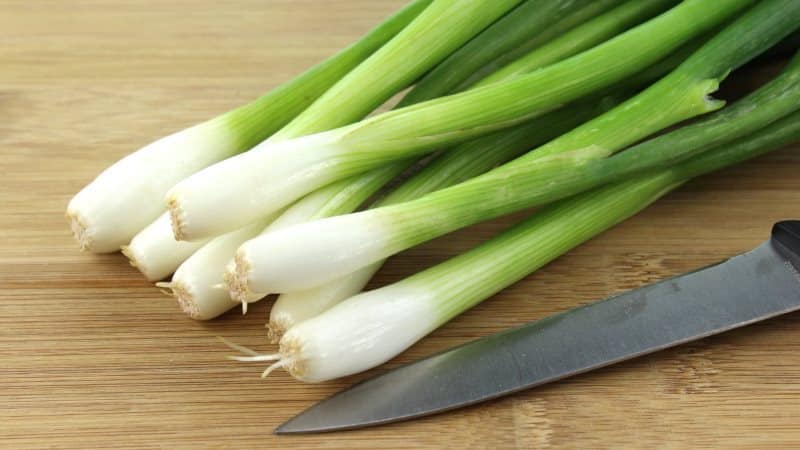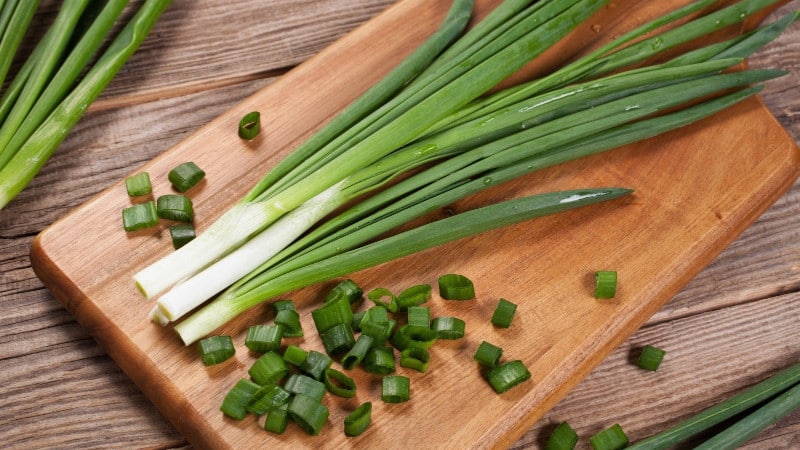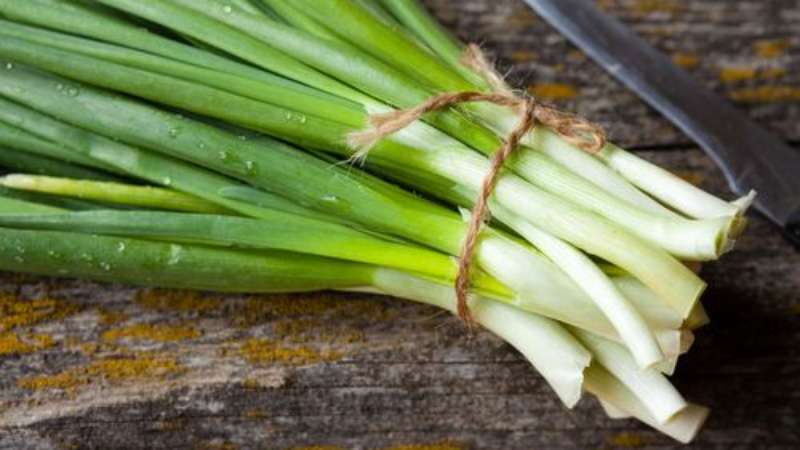Calorie content, benefits and harms of green onions
Green onions are a product with a unique set of vitamins, micro- and macroelements and low calorie content. Fresh green feathers improve the taste of dishes made from meat, fish, vegetables, cereals, eggs, and dry onions are an excellent alternative to salt for those who decide to stop using it. Regular consumption of greens has a beneficial effect on the functioning of internal organs, improves appearance, and improves immunity.
From the material you will learn: how many calories are in green onions, what is their chemical composition and what benefits they bring to the body.
Chemical composition of green onions
Green onions have been used as food since ancient Asia. Wild greens were used as a seasoning for dishes and in raw form by nomadic shepherds. Gradually the culture spread throughout the world.
 Green onions are a source of vitamins, micro- and macroelements, and antioxidants. The product contains about 30 mg of ascorbic acid per 100 g, which is 50% of the daily requirement of the vitamin for an adult. Sulfur is responsible for the specific smell of onions - its amount is 24 mg.
Green onions are a source of vitamins, micro- and macroelements, and antioxidants. The product contains about 30 mg of ascorbic acid per 100 g, which is 50% of the daily requirement of the vitamin for an adult. Sulfur is responsible for the specific smell of onions - its amount is 24 mg.
Table of vitamin and mineral composition of green onions (per 100 g).
| Name | Content | Norm |
| Vitamin A | 333 mcg | 900 mcg |
| Beta carotene | 2 mg | 5 mg |
| Vitamin B1 | 0.02 mg | 1.5 mg |
| Vitamin B2 | 0.1 mg | 1.8 mg |
| Vitamin B4 | 4.6 mg | 500 mg |
| Vitamin B5 | 0.13 mg | 5 mg |
| Vitamin B6 | 0.15 mg | 2 mg |
| Vitamin B9 | 18 mcg | 400 mcg |
| Vitamin C | 30 mg | 90 mg |
| Vitamin E | 1 mg | 15 mg |
| Vitamin H | 0.9 mcg | 50 mcg |
| Vitamin K | 166.9 mcg | 120 mcg |
| Vitamin PP | 0.5 mg | 20 mg |
| Niacin | 0.3 mg | — |
| Potassium | 259 mg | 2500 mg |
| Calcium | 100 mg | 1000 mg |
| Silicon | 5 mg | 30 mg |
| Magnesium | 18 mg | 400 mg |
| Sodium | 10 mg | 1300 mg |
| Sulfur | 24 mg | 1000 mg |
| Phosphorus | 26 mg | 800 mg |
| Chlorine | 58 mg | 2300 mg |
| Aluminum | 455 mcg | — |
| Bor | 220 mcg | — |
| Vanadium | 11.2 mcg | — |
| Iron | 1 mg | 18 mg |
| Iodine | 1.5 mcg | 150 mcg |
| Cobalt | 7 mcg | 10 mcg |
| Lithium | 6 mcg | — |
| Manganese | 0.2 mg | 2 mg |
| Copper | 92 mcg | 1000 mcg |
| Molybdenum | 20 mcg | 70 mcg |
| Nickel | 2.3 mcg | — |
| Rubidium | 453 mcg | — |
| Selenium | 0.5 mcg | 55 mcg |
| Strontium | 25 mcg | — |
| Fluorine | 70 mcg | 4000 mcg |
| Chromium | 4 mcg | 50 mcg |
| Zinc | 0.3 mg | 12 mg |
Calorie content, dietary fat and glycemic index
Nutritional value of the product per 100 g:
- calorie content - 20 kcal;
- proteins - 1.3 g;
- fats - 0.1 g;
- carbohydrates - 3.2 g;
- fiber - 1.2 g;
- water - 93 g.
The glycemic index of green feather is 15 units. Glycemic load is low - 1 unit. This means that the product does not cause a sharp jump in blood sugar, and it is allowed to be used for diabetes.

Beneficial properties of green onions for the body
The benefits of the product are due to its rich chemical composition:
- vitamin B4 helps normalize sleep, improves memory, supports the structure of cell membranes, the transmission of impulses in the central nervous system, accelerates the absorption of fat, reduces inflammatory processes in the body;
- folic acid reduces symptoms of depression, improves mood, sleep and appetite;
- ascorbic acid increases the body's defenses;
- zinc improves the condition of skin, hair, nails, supports the functioning of the immune system;
- essential oils normalize digestive function, remove cholesterol from blood vessels, and lower blood pressure;
- phytoncides have an antibacterial effect and kill fungal infections;
- sulfur has an anti-inflammatory effect, prevents the development of arthritis;
- phosphorus maintains healthy dental tissue and bones;
- beta-carotene serves to prevent decreased visual acuity and the appearance of cataracts;
- fiber regulates intestinal function - improves peristalsis, relieves constipation;
- Regular consumption of green onions helps strengthen blood vessels and restore the functioning of the heart muscle thanks to calcium, potassium, magnesium, and vitamin PP;
- chromium is responsible for regulating blood sugar levels and the slow release of glucose in muscles and cells.
Specialists from the National Cancer Institute in the USA and the Shanghai Cancer Institute in China conducted studies that found that regular consumption of green onions helps bind and remove free radicals, inhibits the formation and growth of cancer cells.
Another study published in the Journal of the National Cancer Institute found that men who frequently consumed green onions had a lower risk of developing prostate cancer compared to those who did not include the product in their menu.
A large amount of folic acid makes onions most beneficial for pregnant women. Consumption of foods rich in folates prevents pathologies in the development of the fetal neural tube and heart muscle. Ascorbic acid helps iron to be absorbed in a woman’s body and prevents the development of fetal hypoxia. Magnesium normalizes muscle tone, heart rate, and strengthens the blood vessels of mother and child. Calcium is useful for the development of fetal bones and maintaining the health of the mother's skeletal system and teeth.
For children, the product is introduced into the diet starting from 8 months, as part of prepared dishes.Raw onions are given after a year. Regular consumption increases the child's body's defenses and improves digestion.
Reference. Christopher Columbus brought onions to America. The culture was first planted on the island of Isabella, and then it spread throughout the mainland.
Medicinal properties of green onions:
- elimination of edema;
- normalization of water-salt balance;
- normalization of blood sugar levels;
- reducing the risk of blood clots;
- normalization of blood pressure;
- prevention of diseases of peripheral vessels and heart muscle.
Nutritionists advise not to give up eating green onions, because they enrich the taste and aroma of dishes made from vegetables, meat, eggs, fish and cereals. Young, tender stems can be eaten raw in fresh salads. The calorie content of green onions is insignificant, only 20 kcal per 100 g, so it can be included in the weight loss menu without fear.
Important! Chewing green feathers for 2-3 minutes kills germs in the mouth, throat, and lips.

Harm and contraindications for use
Harmful properties of green onions:
- specific odor from the mouth after consuming the product;
- irritation of the gastric mucosa;
- increased acidity of gastric juice;
- heartburn and belching;
- reducing the effect of blood thinners.
Contraindications:
- inflammatory liver diseases (hepatitis, cirrhosis);
- stomach ulcer, gastritis;
- bacterial diseases of the gastrointestinal tract;
- high blood pressure;
- bronchial asthma;
- allergy;
- exacerbation of obstructive pulmonary pathologies;
- pancreatitis.
In the stage of remission of inflammatory diseases pancreas and gastrointestinal tract, the product is introduced into the diet gradually and only after consultation with the attending physician.Green feathers are thermally treated to reduce the negative impact on the body.
The ban on eating onions during inflammatory processes in the pancreas is due to the presence of aggressive essential oils in the product, promoting increased secretion of the organ. Fiber, which is part of green feathers, increases gas formation, causing painful and unpleasant sensations.

Read also:
We save children from a runny nose: nasal drops from onion juice.
Conclusion
Green onions are an indispensable component of many dishes. Its moderate bitterness and aroma complement the taste of poultry, fish, eggs, and vegetables. The rich chemical composition of feathers helps strengthen the body's defenses, restore the functioning of internal organs, and reduce the risk of cancer. Minerals strengthen the bone, muscle, and cardiovascular systems.
People suffering from inflammatory diseases of the gastrointestinal tract, allergies, and bronchial asthma should use the product with caution, monitoring the body's reaction.